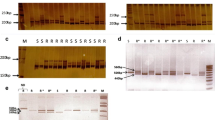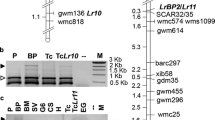Summary
The Mi gene originating from the wild tomato species Lycopersicon peruvianum confers resistance to all major root knot nematodes (Meloidogyne spp.). This single dominant gene is located on chromosome 6 and is very closely linked to the acid phosphatase-1 (Aps-1) locus. Resistance to nematodes has been introgressed into various cultivars of the cultivated tomato (L. esculentum), in many cultivars along with the linked L. peruvianum Aps-1 1 allele. By using a pair of nearly isogenic lines differing in a small chromosomal region containing the Mi and Aps-1 loci, we have identified two RFLP markers, GP79 and H6A2c2, which are located in the introgressed L. peruvianum region. Analysis of a test panel of 51 L. esculentum genotypes of various origins indicated that GP79 is very tightly linked to the Mi gene and allows both homozygous and heterozygous nematode-resistant genotypes to be distinguished from susceptible genotypes, irrespective of their Aps-1 alleles. Marker H6A2c2 is linked to the Aps-1 locus and is capable of discriminating between the L. peruvianum Aps-1 1 allele and the L. esculentum Aps-1 3 and Aps-1 + alleles. In combination, these RFLP markers may provide a powerful tool in breeding tomatoes for nematode resistance.
Similar content being viewed by others
References
Bailey DM (1941) The seedling test methode for rootknot nematode resistance. Proc Am Soc Hortic Sci 38:573–575
Baker KR, Shoemaker PB, Nelson LA (1976) Relationship of initial population densities of Meloidogyne incognita and M. hapla to yield of tomato. J Nematol 8:232–239
Berlinger MJ (1986) Pests. In: Atherton JG, Rudich J (eds) The tomato crop. Chapman and Hall, London, pp 391–441
Bonierbale MW, Plaisted RL, Tanksley SD (1988) RFLP maps based on a common set of clones reveal modes of chromosomal evolution in potato and tomato. Genetics 120:1095–1103
Feinberg AP, Vogelstein B (1984) A technique for radiolabeling DNA restriction endonuclease fragments to high specific activity. Anal Biochem 137:266–267
Fobes JF, Rick CM (1976) Aps, Est, and Got phenotypes. TGC Rep 26:7–9
Frazier WA, Dennett RK (1949) Isolation of Lycopersicon esculentum type tomato lines essentially homozygous resistant to root knot. Proc Am Soc Hortic Sci 54:225–236
Gebhardt C, Ritter E, Debener T, Schachtschabel U, Walkemeier B, Uhrig H, Salamini F (1989) RFLP analysis and linkage mapping in Solanum tuberosum. Theor Appl Genet 78:65–75
Gilbert JC (1958) Some linkage studies with the Mi gene for resistance to root knot. TGC Rep 8:15–17
Herrmann BG, Labeit S, Poustka A, King TR, Lehrach H (1990) Cloning of the T gene required in mesoderm formation in the mouse. Nature 343:617–622
Hussey RS (1985) Host-parasite relationships and associated physiological changes. In: Sasser JN, Carter CC (eds) An advanced treatise on Meloidogyne, vol, 1. North Carolina State University Graphics, Aleigh/NC, pp 143–153
Koornneef M, Zabel P (1990) A new look at old linkage data of chromosome 6. TGC Rep 40:17–19
Loh WHT, Kut SA, Evans DA (1987) A novel strategy for the development of nematode-resistant tomatoes. In: Arntzen CJ, Ryan C (eds) Molecular strategies for crop protection. Alan R. Liss, New York, pp 367:373
MacFarlane JS, Hartzier E, Frazier WA (1946) Breeding tomatoes for nematode resistance and for high vitamin C content in Hawaii. Proc Am Soc Hortic Sci 47:262–270
Maniatis T, Fritsch E, Sambrook J (1982) Molecular cloning: a laboratory manual. Cold Spring Harbor Laboratory Press, Cold Spring Harbor/NY
Medina-Filho HP (1980) Linkage of Aps-1, Mi, and other markers on chromosome 6. TGC Rep 30:26–28
Medina-Filho HP, Stevens MA (1980) Tomato breeding for nematode resistance: survey of resistant varieties for horticultural characteristics and genotype of acid phosphatases. Acta Hortic 100:282–392
Medina-Filho HP, Tanksley SD (1983) Breeding for nematode resistance. In: Evans DA, Sharp WR, Ammirato PV (eds) Handbook of plant cell culture, vol 1. Techniques for propagation and breeding. MacMillan, New York, pp 904–923
Mendoza HA, Jatala P (1985) Breeding potatoes for resistance to the root knot nematode Meloidogyne species. In: Sasser JN, Carter CC (eds) An advanced treatise on Meloidogyne, vol I. North Carolina State University Graphics, Raleigh/NC, pp 217–224
Murray MG, Thompson WF (1980) Rapid isolation of highmolecular-weight plant DNA. Nucleic Acids Res 8:4321–4325
Orkin SH (1986) Reverse genetics and human disease. Cell 47:845–850
Rick CM (1969) Controlled introgression of chromosomes of Solanum pennellii into Lycopersicon esculentum: segregation and recombination. Genetics 62:753–768
Rommens JM, Iannuzzi MC, Kerem B, Drumm ML, Melmer G, Dean M, Rozmahel R, Cole JL, Kennedy D, Hidaka N, Zsiga M, Buchwald M, Riordan JR, Tsui L, Collins FS (1989) Identification of the cystic fibrosis gene: chromosome walking and jumping. Science 245:1059–1065
Sarfatti M, Katan J, Fluhr R, Zamir D (1989) An RFLP marker in tomato linked to the Fusarium oxysporum resistance gene I2. Theor Appl Genet 78:755–759
Smith PG (1944) Embryo culture of a tomato species hybrid. Proc Am Soc Hortic Sci 44:413–416
Tanksley SD, Bernatzky R, Lapitan NL, Prince JP (1988) Conservation of gene repertoire but not gene order in pepper and tomato. Proc Natl Acad Sci USA 85:6419–6423
Van Daelen RAJ, Jonkers JJ, Zabel P (1989) Preparation of megabase-sized tomato DNA and separation of large restriction fragments by field inversion gel electrophoresis (FIGE). Plant Mol Biol 12:341–352
Wang ELH, Bergeson GB (1974) Biochemical changes in root exudate and xylem sap in tomato plants infected with Meloidogyne incognita. J Nematol 6:194–202
Watts VM (1947) The use of Lycopersicon peruvianum as a source of nematode resistance in tomato. Proc Am Soc Hortic Sci 49:233–234
Young ND, Zamir D, Ganal MW, Tanksley SD (1988) Use of isogenic lines and simultaneously probing to identify DNA markers tightly linked to the Tm-2a gene in tomato. Genetics 120:579–585
Author information
Authors and Affiliations
Additional information
Communicated by F. Salamini
Rights and permissions
About this article
Cite this article
Klein-Lankhorst, R., Rietveld, P., Machiels, B. et al. RFLP markers linked to the root knot nematode resistance gene Mi in tomato. Theoret. Appl. Genetics 81, 661–667 (1991). https://doi.org/10.1007/BF00226734
Received:
Accepted:
Issue Date:
DOI: https://doi.org/10.1007/BF00226734




